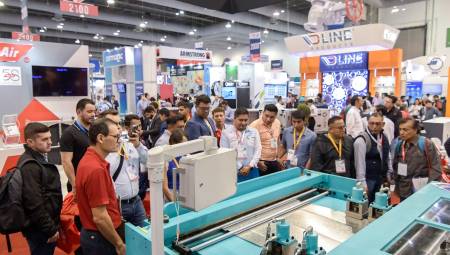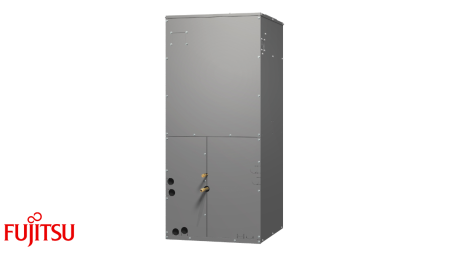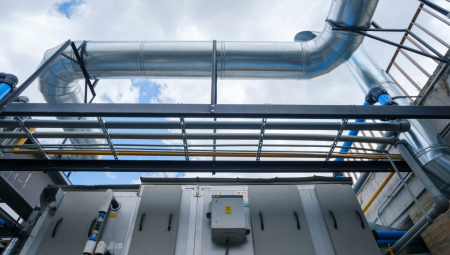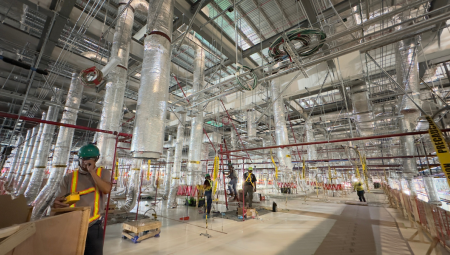
In a building outside we are under the influence of nature by the action of variable winds, but the temperature inside the building can be controlled efficiently.
Heat produced by the transmission of mezzanines, walls, ceilings, doors, windows, among others
The heat gain by conduction through the envelope of a building under study (walls, ceilings, floors and windows), is calculated with the equation resulting from the solution of the equation of conduction without storage (d2 T / dx = 0), for the case of flow through walls, ceiling and floor, which can be considered as flat plates, the solution is:
Ct = U x W x ∆t
Ct = Heat transmitted, thermal flux in watts U = Coefficient of transmission of the material in w / m2 ºC A = Area of the transmission surface (conductance) of the material in m2 ∆t = Temperature differential between the outside temperature (Temp. ext.) and the interior temperature (Temp. int.) in degrees CelsiusHere we will explain how the materials of a wall, roof, etc. behave thermally. It is observed that they isolate in different ways, that is, they delay the passage of heat or cold. We also see the action of the wind on the outside and inside, which when colliding with the surfaces disperse in all directions in a laminar form and generate friction.
This form of heat transmission occurs by "transmission and convection" of everything around the space to be conditioned.
TOTAL HEAT TRANSFER COEFFICIENT "U"
The total heat transfer coefficient "U" is defined as the total intensity of heat transfer through a material.
The factor "U" as it is commonly called, is the resulting heat transfer coefficient after taking into account the thermal conductivity and conductance of the surface layer, its units are: (SI) watts / hr x m2 of area x temperature difference in ºC or (Sist. metric) Kcal. / hr. x m2 area x temperature difference in ºC or (English Sist.) BTU/ hr x foot2 area x temperature difference in ºF.
It is normally applied to composite structures, such as walls, ceilings and roofs.
To calculate the factor "U", one finds first the total resistance and then its reciprocal.
To know "U" we must know with which materials it is going to be built, its thickness, the conductance of the same, the speed of the external wind and the movement of the interior air. For this there is a table of materials (See Table 1) of which their transmission coefficients "U", conductivity "K" and convection "f" will be known; therefore to calculate "U" we will use the following expression.
U= 1= __________________________________W_R _1 + 1 + _ 1 _ + E1 + E2 + _ E3 + ... tags. m2 . fi fe to K1 K2 K3 Where: R = Resistance of the element. fi = Coefficient of convection to the interior in watts/m2 ºC (indoor air film) fe = Coefficient of convection to the outside in watts/m2 ºC (outer air film) a = Coefficient of heat transmission of air by convection, as use of, air chamber in vertical and horizontal spaces. K 1... K 3 = Coefficients of thermal conductivities of materials in watts m / ºC m2 and one m thick. E1 ... E3 = Thicknesses of materials in meters.
The total heat transferred by conduction varies directly with time, area and temperature difference, and inversely with the thickness of the material.
Heat gain through walls, floors and ceilings will vary according to the following characteristics:
A) Type of construction.B) Area exposed to different temperature.C) Type and thickness of the insulator. D) Temperature difference between the conditioned space and the ambient temperature..
THERMAL RESISTANCE "R"
Thermal resistance "R" is defined as the resistance of a material to heat flow, and is by definition, the reciprocal of the heat transfer coefficient R = 1/C
Its units are: International System (SI) Temperature difference in ºC x m2 of area / watts / hr or Metric System temperature difference in ºC x m2 of area / Kcal / hr. o English system temperature difference x foot2 area / BTU / hr.
"R" is very useful since resistance values can be added together in numerical form.
R total = R1 + R2 + R3
Where:
R1, R2, R3 are individual resistors.
CONDUCTANCE "C"
Thermal conductance "C" is defined as the intensity of heat transfer that is had through a material and its units are: (SI) Watt / hr. x m2 area x temperature difference in ºC or ( SM ) Kcal / hr x m2 area x temperature difference in OC o (S English ) BTU / hr x foot2 area by temperature difference in ºF. This is a factor frequently used with building materials, air spaces, etc., and differs solely from thermal conductivity in that it is a factor for a given thickness of a material, while thermal conductivity is a heat transfer factor per meter of thickness.
THERMAL CONDUCTIVITY "K"
Thermal conductivity is defined as the intensity of heat transfer through a material, its units are:
watt / hr x m2 of area x temperature difference in ºC x 1 m of thickness.
To reduce heat transfer through a material, the thermal conductivity factor "K" should be as small as possible, in turn the material should be as thick as possible.
Figure 2: Outer wall Here we see how transmission and convection act simultaneously. x Material Thickness in m K 1 Outer air film 29.1 2 Mortar flattening 0.02 0.87 3 Annealed red partition 0.13 0.87 4 Plaster flattening 0.02 0.70 5 Indoor air film 9.3
x Material Thickness in m K 1 Outer air film 29.1 2 Mortar flattening 0.02 0.87 3 Annealed red partition 0.13 0.87 4 Plaster flattening 0.02 0.70 5 Indoor air film 9.3CONDUCTANCE OF THE SURFACE LAYER OF AIR
The transfer of heat through any material is related to the surface resistance of the air to the flow of heat, and is determined according to the type of surface, (rough or smooth), its position, (horizontal or vertical), its reflective properties and the intensity of air flow on the surface. The conductance of the surface layer of air is normally designated with "fi", for interior surfaces, and "fe" for exterior surfaces.
Convection acts on the outside (fe) and inside (fi), in these two examples you can see how it exerts an action or force on the surfaces and this is transformed into heat, of course in a very low range, however it should be noted that the air currents are greater, the greater the amount of heat that is generated.
On the outside the influence of nature intervenes by the action of variable winds, but on the inside it can be controlled.
The heat transmission that occurs by the different materials, we can know by the following equation: (see figure No.2)
U= 1= _______________________________________________________________________ WattsR _1_ + _ 1_ + _ 2_ + _ 0.13_ + 0.02 m2 0C 29.1 9.3 0.87 0.87 0.70
To know the "U" of the roof slab we will use the fig. No. 3, in which the air conditioner will be injected through the upper part of the room (point 10 of the fig. indicated)
U= _1_= _________________________________________________________________ C 29.1 7.0 0.87 0.87 0.23 1.28 0.19 1.74 5.5 0.7For the values of "U" of window, door and floor we go to the table of materials and their coefficients (See Table 1), in these cases it is not necessary to calculate it since they are very common and have already been analyzed.
It is worth mentioning that a good thermal insulator is one whose density is low and which contains many air chambers (fluffy).
An excellent thermal insulator is the air chamber, but for this to happen it must have a recommended space of 10 cm, between layer and layer of material.
It is very important the proper selection of thermal construction materials for each work, which must meet qualities such as: light, easy to place, minimal maintenance, durable, resistant to the passage of time, free of moisture. All these qualities must be taken into account in order to select the materials, appropriate to the environment and also aesthetic, with this you can avoid large air conditioning equipment obtaining the desired comfort.
When the considerations of heat gains are made, we must know the temperatures of the outside and if possible those of the neighboring premises, to know if the space to be conditioned will have gains or losses of heat.
The standards related to energy saving are: Material Thickness in m K Material Thickness in m K 1 Outer air film 29.1 6 Tezontle 12 0.19 2 Brick 1.5 0.87 7 Concrete 10 1.74 3 Mortar 3.0 0.87 8 Air (full chamber) 5.5 4 Waterproofing 0.5 0.23 9 Plaster ceiling 1.5 0.7 5 Entortado 4 1.28 10 Indoor air with downward flow 7
Material Thickness in m K Material Thickness in m K 1 Outer air film 29.1 6 Tezontle 12 0.19 2 Brick 1.5 0.87 7 Concrete 10 1.74 3 Mortar 3.0 0.87 8 Air (full chamber) 5.5 4 Waterproofing 0.5 0.23 9 Plaster ceiling 1.5 0.7 5 Entortado 4 1.28 10 Indoor air with downward flow 7To calculate temperatures on the exterior and interior surfaces
This becomes very important because you can know what temperatures there will be on the surfaces of the elements that will be built.
Interior surface: CTV (heat transmitted through the window) = U x ∆t (Ti – Te); CTV=6.4 w/h m2 OC x (23 –(-10)=211.2 w/m2
CTV = 211.12 = 22.71 ºC fi 9.3 Ti = Indoor temperature - 22.71 ºC; Ti = 23 – 22.71 = 0.29 ºC Outer surface CTV = 211.12 = 7.25 ºC fi 29.1 Te = Outdoor temperature + 7.25 ºC; Te = -10 + 7.25 ºC = -2.75 ºC Figure 4: Heat transmitted through the window
HEAT GAINS FROM UNCONDITIONED ADJOINING SPACES
Transmission heat = Area x ∆t x U
∆t = Temperature difference of a conditioned room and an unconditioned room TBS Local unconditioned – TBS local conditioned.
Temperature inside an unconditioned room, is approximately 3 ºC cooler than outside, being the outside temperature the one marked on the AMICA charts (for summer).
The kitchens as well as the machine rooms will be approximately 8 to 11 ºC higher than the summer temperature outside.
Table 1 Coefficients of Thermal Conductivity of Various Materials Kg./m2 K Watts/m2 0CM K Watts/m2 0C Rubber foam 20 0.4 Perlite 65 0.4 Polystyrene, plate 15 0.4 Polyurethane, foam 30 0.03 Polyurethane, rigid plate 30 0.02 Vermiculite 100 0.07 Various Materials Glass 2600 1.16 Triplay 530 0.14 Pressed chip 400 0.16 Oak wood, dry, 90º fiber 950 0.16 White pine wood, dry, 90º of the fibre 600 0.14 White pine wood, exposed to rain 650 0.21 Melting asphalt 2100 0.81 Bituminous asphalt 1050 0.17 Linoleum, dry 0.19 Cotton, dry 0.05 Pure wool, dry 0.05 Cottonseed shell, loose, dry 0.06 AIR space in any position 1.2 5.50 Water 1000 0.58 Steel and iron 7800 52.34 Copper 8900 372.16 Stainless steel 7800 46.52 Aluminium 2675 210.74 Bronze 1000 63.97 Galvanized iron 1500 46.52 Silver 407.05 Lead 33.96 Zinc 110.02 Finishes Tiles and mosaics 2000 1.05 Flattening with cement mortar outside 2000 0.87 Flattening with lime mortar inside 1500 0.70 Terrazzos and cement mortar floors 2000 1.74 Gypsum 1500 0.70 Mortar with vermiculite 500 0.18 Liming 1800 0.81 Tablaroca (plaster-cardboard) 950 0.16 Linoleum 1200 0.19 Expanded polyvinyl chloride 25 0.04 Plexis 1200 0.20 Transmission Coefficients Floors Floor or basement (winter-summer) 0.28 Steel doors in Outdoor 6.40 Of steel indoors 3.49 Of solid wood from 2 to 6.5 cm. 2.91 Of drum wood 1.86 Windows and skylights Single 6 mm Cs 0.94 6.40 Doubles 6 mm c/u Cs 0.80 3.49 Triples 6 mm c/u Cs 0.81 1.63 20x20x10 glass blok 2000 Outdoor 2.79 Indoor 2.33 Convection Coefficients (f) Surface to outside air (fe) Wind speed 12Km/h or less (3.33m/sec or less) 23.3 Wind speed 18Km/h or less (5.0m/sec or less) 29.1 Wind speed 24Km/h or less (6.67m/sec or less) 34.9 Inner vertical surface (fi) 9.3 Inner horizontal surface (fi) Downward flow 7.0 Inner horizontal surface (fi) Upward flow 10.5——————————————————————————













